英语语法-副词和副词词组
- 格式:doc
- 大小:147.00 KB
- 文档页数:33
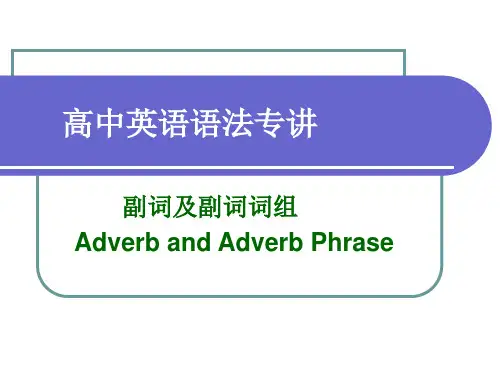
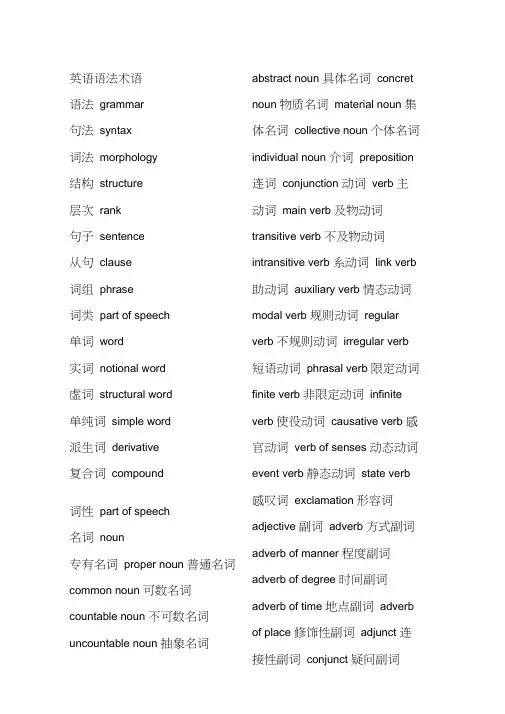
英语语法术语语法grammar句法syntax词法morphology结构structure层次rank句子sentence从句clause词组phrase词类part of speech单词word实词notional word虚词structural word单纯词simple word派生词derivative复合词compound词性part of speech名词noun专有名词proper noun 普通名词common noun 可数名词countable noun 不可数名词uncountable noun 抽象名词abstract noun 具体名词concret noun 物质名词material noun 集体名词collective noun 个体名词individual noun 介词preposition 连词conjunction 动词verb 主动词main verb 及物动词transitive verb 不及物动词intransitive verb 系动词link verb 助动词auxiliary verb 情态动词modal verb 规则动词regular verb 不规则动词irregular verb 短语动词phrasal verb 限定动词finite verb 非限定动词infinite verb 使役动词causative verb 感官动词verb of senses 动态动词event verb 静态动词state verb 感叹词exclamation 形容词adjective 副词adverb 方式副词adverb of manner 程度副词adverb of degree 时间副词adverb of time 地点副词adverb of place 修饰性副词adjunct 连接性副词conjunct 疑问副词interrogative adverb 关系副词relative adverb代词pronoun 人称代词personal pronoun 物主代词possessive pronoun 反身代词reflexive pronoun 相互代词reciprocal pronoun 指示代词demonstrative pronoun 疑问代词interrogative pronoun 关系代词relative pronoun 不定代词indefinite pronoun 物主代词possessive pronoun 名词性物主代词nominalpossessive pronoun 形容词性物主代词adjectival possessive pronoun冠词article定冠词definite article 不定冠词indefinite article数词numeral基数词cardinal numeral 序数词ordinal numeral 分数词fractional numeral形式form单数形式singular form 复数形式plural form 限定动词finite verb form 非限定动词non-finite verb form 原形base form从句clause从属句subordinate clause 并列句coordinate clause 名词从句nominal clause 定语从句attributive clause状语从句adverbial clause 非真实条件状语从句adverbial宾语从句object clause主语从句subject clause 同位语从句appositive clause时间状语从句adverbial clause of time地点状语从句adverbial clause ofplace方式状语从句adverbial clause ofmanner让步状语从句adverbial clause ofconcession原因状语从句adverbial clause ofcause结果状语从句adverbial clause ofresult目的状语从句adverbial clause ofpurpose条件状语从句adverbial clause of condition真实条件状语从句adverbial clause of real conditionclause of unreal condition 含蓄条件句adverbial clause of implied condition 错综条件句adverbial clause of mixed condition 句子sentence简单句simple sentence 并列句compound sentence 复合句complex sentence 并列复合句compound complex sentence陈述句declarative sentence 疑问句interrogative sentence 一般疑问句general question 特殊疑问句special question 选择疑问句alternative question 附加疑问句tag question 反义疑问句disjunctive question 修辞疑问句rhetorical question 感叹疑问句exclamatory question存在句existential sentence 肯定句positive sentence基本句型basic sentence pattern 否定句negative sentence 祈使句imperative sentence 省略句elliptical sentence 感叹句exclamatory sentence句子成分members of sentences 主语subject谓语predicate 宾语object 双宾语dual object 直接宾语direct object 间接宾语indirect object 复合宾语complex object 同源宾语cognate object 补语complement 主补subject complement 宾补object complement表语predicative定语attribute 同位语appositive 状语adverbial句法关系syntactic relationship 并列coordinate 从属subordination 修饰modification前置修饰pre-modification 后置修饰post-modification 限制restriction双重限制double-restriction 非限制non-restriction数number单数形式singular form 复数形式plural form 规则形式regular form 不规则形式irregular form格case普通格common case 所有格possessive case 主格nominative case宾格objective case性gender阳性masculine阴性feminine通性common中性neuter人称person第一人称first person第二人称second person 第三人称third person时态tense过去将来时past future tense 过去将来进行时past future continuous tense 过去将来完成时past future perfect tense一般现在时present simple tense 一般过去时past simple tense 一般将来时future simple tense 现在完成时past perfect tense 过去完成时present perfect tense 将来完成时future perfect tense 现在进行时present continuous tense过去进行时past continuous tense将来进行时future continuous tense过去将来进行时past future continuous tense 现在完成进行时present perfect continuous tense过去完成进行时past perfect continuous tense 语态voice 主动语态active voice 被动语态passive voice语气mood陈述语气indicative mood 祈使语气imperative mood 虚拟语气subjunctive mood否定negation否定范围scope of negation 全部否定full negation 局部否定partial negation 转移否定shift of negation语序order自然语序natural order倒装语序inversion全部倒装full inversion 部分倒装partial inversion直接引语direct speech 间接引语indirect speech 自由直接引语free direct speech 自由间接引语free indirect speech一致agreement主谓一致subject-predicate agreement语法一致grammatical概念一致notional agreement 就近原则principle of proximity强调emphasis重复repetition 语音pronunciation 语调tone 升调rising tone 降调falling tone 降升调falling-rising tone文体style 正式文体formal 非正式文体informal 口语spoken/oral English 套语formulistic expression 英国英语British English 美国英语American English 用法usageTerms of English Language Teaching Methodologyagreement感情色彩emotional coloring 褒义commendatory 贬义derogatory 幽默humorous讽刺sarcastic挖苦ironicachievement test acquisition acquisition active mastery active vocabulary affective filtering aim,objective analysis of errors analytic approach analytical reading 英语教学法术语成绩测试习得,语言习得语言习得顺序积极掌握积极词汇,主动词汇情感筛选目的,目标错误分析分析教学法,分析法分析性阅读application to practice 运用于实践approach 教学路子aptitude test 能力倾向测验Army method 陆军法associative learning 联想性学习auditory discrimination 辨音能力auditory feedback 听觉反馈auditory memory 听觉记忆auditory perception 听觉audio-lingual method 听说法audio-visual method 视听法aural-oral approach法听说教学法,听说aural-oral method 听说法Bbasic knowledge基本知识basic principle 基本原则basic theory 基本理论basic training 基本训练basic vocabulary 基本词汇behaviourism 行为主义bilingual 双语的bilingual education 双语教育chain drill 链式操练,连锁操练choral repetition 齐声照读,齐声仿读class management 课常管理classroom interaction 课常应对cloze 完形填空coach 辅导cognitive approach 认知法common core 语言的共同核心,语言共核communicative drill 交际性操练communicative exercise 交际练习communicative langunge teaching 派语言教学法,交际教学法交际community language learning学习法集体语言comparative method 比较法communicative approach 交际法comprehensible input 不难理解的输入comprehensive method 综合法computer-managed instruction管理教学计算机concord and coordination 默契与配合console 控制台consonant cluster 辅音连缀applied linguistics 应用语言学blank filling 填空context 上下文controlled composition 控制性作文direct learning 直接学习cue word 提示词curriculum 课程,教学大纲curriculum development课程设计课程编制,cultrual objective,aim 教养目的cclical approach 循环教学法,循环法Ddeductive learning演绎性学习deductive method 演绎法delayed auditory feedback馈延缓听觉反demonstration 演示educational objective, aim 教育目的EFL 英语作为外语EGP通用英语ELT 英语教学English as a Foreign Language 为外语英语作English as an InternationalLanguage 英语作为国际语言English environment 英语环境English for Academic Purposes语学术英English for general prupose 普通英语English for General Purposes 语通用英demonstration lesson 示范教学describe a picture in writing 看图说话describe a picture orally 描写语言学diagram 图解diagnostic test 诊断性测验dicto-comp 听写作文direct application 直接应用English for specific purposes 专用英语ESOL English for Speakers of Other Languages 供非英语民族使用的英语English medium school 英语授课学校English teaching;teaching English 英语教学WSD( English as a Second Dialect ) 英语作为第二方言WSL( English as a Second Language) 英语作为第二语言course density 课堂密度course design 课程设计cramming method 灌输式direct method 直接教学法direct comprehension 直接理解ESL Programme( English as a Second Language Programme)英语(第二语言)教程ESP( English for Special Purposes ) 专用英语EST( English for Science andTechnology ) 科技英语evaluation 评语,评价examination 考试examination question 考题experimental method 实验法extensive reading 泛读external speech 外语言语extra-curiculum activity 课外活动extra-curriculum club,group 课外小组F al approach 功能法al syllabus 功能派教学大纲word 功能词Ggeneral linguistics 普通语言学gestalt style 格式塔式(学习),整体式(学习)gesture 手势getting students ready for class 织教学组global learning 式学习整体式学习,囫囵吞枣global question 综合性问题gradation 级进法,分级递升法graded direct method 循序直接法grading 级进法,分级递升法;评分facial expression feedbace 反馈film projector filmstrip finalstage first language formative evaluation free practice面部表情电影放映机高级阶段第一语言,母语自由作文自由练习电影胶片grammar lessongrammar methodgrammar translation method法grammatical analysisgroup readinggroup trainingguided composition语法课语法法语法翻译语法分析集体朗读集体练习引导性作文frequency of word 词的频率H integrated approach法综合教学法,综合heuristic method of teaching 教学法启发式intelligent memory 理解性记忆heurstics 启发法;探索法language training强化教学humanistic approach 人本主义教学法intensive training 精读intermediate stage 中级阶段Iinterpretation头口翻译idealism 唯心主义International Phonetic Alphabet 国际imitatiom 模仿音标immersion programme 沉浸式教学Jimparting knowledge 传授知识juncture连读,音渡incomplete plosive 不完全爆破junior high school初级中学independent composition 独立作文junior school初级学校individualized instruction 个别教学junior sceondary school初级中等学校individual training 个别练习junior-senior high school初高中inductive learning 归纳性学习junior technical college(orinductive method 归纳法school) 初级职业学院(或学校)inflection,inflexion 词形变化junior year 大学三年级information,processing 信息处理Kinitial beginning stage 初级阶段key words基本词,关键字inner speech 内语言语kinesics 身势语,身势学in-service training 在职培训kinesthetic memory 动觉记忆instructional objective 语言教学目标knowledge知识integrative teaching 综合教学knowledge structure 知识结构Llanguage acquisition 语言习得language acquisition device 语言习得机制language arts 语言技能language competence,or knowledge 语言知识language learning capability 语言学习能力language laboratory;lab 语言实验室language leaning capacity 语言学习能力language pedagogy 语言教育language performance 语言行为language program design 语言课程设计language test 语言测试learning by deduction 演绎性学习learning by induction 归纳性学习learning process 学习过程learning style 学习方式lesson conducting 教课lesson plan 课时计划,教案lesson preparation 备课lesson type 课型linguistics 语言学linguistic method 口语领先教学法living language 活的语言long-term memory 长期记忆look-and-say method 看图说话法meaningful drill 有意义的操练neabubgful exercise 有意义的练习meaningful learning 理解性学习means of teaching 教学手段mechanical drill 机械操练mechanical exercise 机械练习mechanical memory 机械记忆mechanical translation 机器翻译medium of instruction 学语言教学媒介语,教memory 记忆,记忆力memory span 记忆幅度memorizing 用记记住method 方法methodology of teaching 教学法methodology of teaching English 教学法英语microteaching 微型教学mim-mem method 模仿—记忆法linguistic competence 语言能力minimal pair 习)最小对立体(一种辨音练optimum age hypothesis说学习最佳年龄model 模型operating principle 操作原则modeling 示范教学oral approach 口语教学法,口语法modern equipment 现代化设备oral exercise 口语练习modern language 现代语言oral method 口授法monitor hypothesis 语言监控说oral reading 朗读mother tongue 母语order of acquisition 语言习得顺序motivation 引起动机organization of teaching materials 教材组织Norgans of speech 发音器官native language 本族语outside reading课外阅读natural appoach 自然教学法,自然法overlearing过量学习natural method 自然法Pneeds analysis 需要分析paired-associate learning 配对联想学new lesson 新课习法nine-pile grading 九堆法pair work 双人作业,双人练习notional approach 意念法passive vocabulary消极词汇notional-al syllabus 意念- 功能派教学pattern drill 句型操练大纲pattern practice 句型练习notional syllabus 意念大纲、意念派教学大纲pdeagogical grammar 教学语法Opedagogy 教育法peer teaching 同学互教observation lesson观摩教学penmanship handwriting 书法objective 教学目标知觉perceptionperformance objective 语言实践目标proficiency 熟练personality 个性program desing 课程设计philosophy 哲学psycho-linguistics 心理语言学phoneme 音素psychological method 心理法phonetics 语音法Qphonetic method 按字母音值拼读法qualified teacher 合格教师phonology 音位学question band 试题库picture 图画questionnaire 调查问卷phasement test 分班测验questions 提问plateau of learning 学习高原Rpractical objective 实用目的practice effect练习效应rapid reading 快速阅读,快读practice of teaching教学实践rate of reading 阅读速度presentation of new materials 提出新readability 易读性材料read by turns轮读pre-teaching 预教reading 阅读primary of speech 口语领先reading lesson 阅读课principle of communication 则交际性原reading method 阅读法principle ofteaching 教学原则reading speed 阅读速度problem solving 习题解答reading vocabulary汇量阅读词汇,阅读词production stage 活用阶段,产出阶段receptive language knowledge 接受性productive exercise 活用练习语言知识receptive vocabulary 领会词汇productive mastery 活用掌握productive vocabulary 活用词汇reformed method 改良法regression 回看,重读reinforcement 巩固reinforcement lesson 巩固课repetition drill 复述操练repetition-stage 仿照阶段response 反应retelling 复述retention 记忆teview;tevision 复习review ( revise ) 查and check up复习检review ( revision )lesson 复习课rewriting 改写rhythm 节奏role-play 扮演角色rote learning 强记学习法,死记硬背Sscanning 查阅,扫瞄school practice 教学实习scientific way of thinking 想方法科学的思second language 第二语言segment 音段,切分成分semantics 语义学seminar 课堂讨论sentence completion 完成句子short-term memory 短期记忆sight vocabulary 一见即懂的词汇silent reading 默读silent way 沉默法,静授法simplification 简写simplified reader 简写读本simulation 模拟,模拟性课堂活动simultaneous interpretation 同声翻译situational method 情景法situational language teaching 情景派语言教学法,情景教学法situational method 情景教学法situational syllabus 情景派教学大纲situation reinforcement 情景强化法skimming 略读,济览slide 幻灯片slide projector 幻灯片socialized speech 社会化言语socio-linguistics 社会语言学soft ware 软件speech disorder 言语缺陷speech pathology 言语病理学speech perception 言语知觉speech reading 唇读法speed reading 快速阅读,快读speelling 正字法spiral approach 螺旋式教学法,螺旋法spoken lauguang 口语stage of teaching 教学阶段stick drawing;mathch drawing 简笔画stimulus and response 刺激与反应stress accent 重音,重读structuralism 结构主义(语言学)structural method 结构法student-centered 学生中心student-centered learning习法学生为主学student teacher 实习教师student teaching 教育实习submersion programme 沉浸式教程substitution 替换substitution table 替换表subvocal reading 默读suggestopaedia 暗示教学法syllabus 教学大纲syllabus design 教学大纲设计syllabus for middle school English 中学英语教学大纲synthetic approach 综合性教学法,综合法synthetical reading 综合性阅读Ttarget language目的语,译文语言teacher ' s book 教师用书teacher ' s manual 教师手册teaching experience 教学经验teaching objective,aim 教学目的teaching procedure 教学过程teaching tools;property 教具teaching words in isolation词孤立教单theory of teaching 教学理论TEFL 英语(外语)教学TESL 英语(第二语言)教学TESOL 对非英语民族教英语time allotment 时间分配total physical response method 整体动作反应法transformation drill 转换操练translation method 翻译法transformational generativegrammar 转化生成语法Uunconscious潜意识underclassman 低年级学生undergraduate course 大学本科课程undergraduate school 大学本科学院undergraduate special 大学特殊课程unified studied 统一课程university high school 大学附属中学university of the air 广播电视大学word association 词际联想word list 词表word study 词的研究word frequency 词汇重复率written language 书面语updating courses/training 现代化课程/ 训练upgrading courses/training 进修课程/ 训练upperclassman 高年级学生use and usage 使用和用法utterance 语段Vverbal association词语联想verbal learning 语言学习,单词学习video 电视,影象videotape 录象磁带visual perception 视觉visual aid 直观手段visit a class 听课visual memory 视觉记忆vocabulary control 词汇控制感情色彩emotional coloring褒义commendatory贬义derogatory幽默humorous讽刺sarcastic挖苦ironic英语教学术语Approach 教学路子undergraduate 大学本科生Communicative approach 交际法论Communicative language teaching交际语言教学Method 教学方法Syllabus design教学大纲设计Frist language母语Second language第二语言Foreign language外语Target language目的语言Techniques技巧Brainstorm 指就某一问题随便发表观点或建议的过程Group-work 小组活动Pair-work 两人一组的活动View of work 语言理论或对语言的认识Structural view 结构主义语言理论Functional view 功能主义语言理Interactional view 交互语言理论Behaviourist theory 行为主义学习理论Cognitive theory 认知学习理论Process-oriented theory 强调过程的语言学习理论Condition-oriented theory 强调条件的语言学习理论Audiolingual theory 外语教学听说法TPR:total physical respone 全身反应法Silent way 沉默法Natural approach 自然法Reflective teaching反思教学Communicative approach 交际法或交际路子Communicative competence 交际能力Linguistic competence语言能力Teaching procedures教学步骤Teaching aids 教学辅助材料和设备Variety 多样性Flexibility 灵活性Learnability 可学性Linkage连接Micro planning 微观备课Macro planning 宏观备课RP:received pronunciation 英国伦敦附近的一种方言。
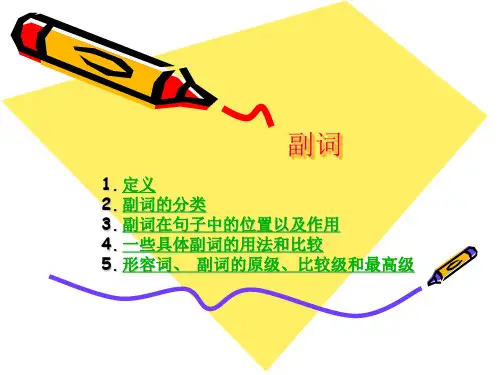
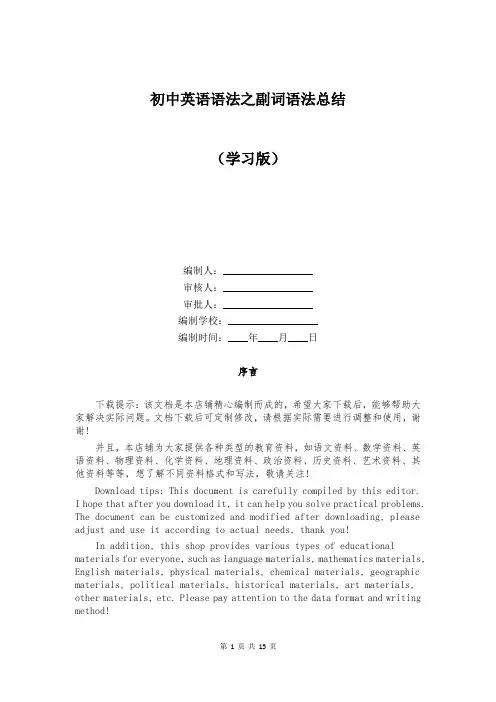
初中英语语法之副词语法总结(学习版)编制人:__________________审核人:__________________审批人:__________________编制学校:__________________编制时间:____年____月____日序言下载提示:该文档是本店铺精心编制而成的,希望大家下载后,能够帮助大家解决实际问题。
文档下载后可定制修改,请根据实际需要进行调整和使用,谢谢!并且,本店铺为大家提供各种类型的教育资料,如语文资料、数学资料、英语资料、物理资料、化学资料、地理资料、政治资料、历史资料、艺术资料、其他资料等等,想了解不同资料格式和写法,敬请关注!Download tips: This document is carefully compiled by this editor.I hope that after you download it, it can help you solve practical problems. The document can be customized and modified after downloading, please adjust and use it according to actual needs, thank you!In addition, this shop provides various types of educational materials for everyone, such as language materials, mathematics materials, English materials, physical materials, chemical materials, geographic materials, political materials, historical materials, art materials, other materials, etc. Please pay attention to the data format and writing method!初中英语语法之副词语法总结新一轮中考复习备考周期正式开始,本店铺为各位初三考生整理了中考五大必考学科的知识点,主要是对初中三年各学科知识点的梳理和细化,帮助各位考生理清知识脉络,熟悉答题思路,希望各位考生可以在考试中取得优异成绩!下面是《2022初中英语语法之副词语法总结》,仅供参考!一、概说副词主要用于修饰动词,也可用于修饰形容词、副词、介词短语以及句子,表示时间、地点、方式、程度、疑问等。

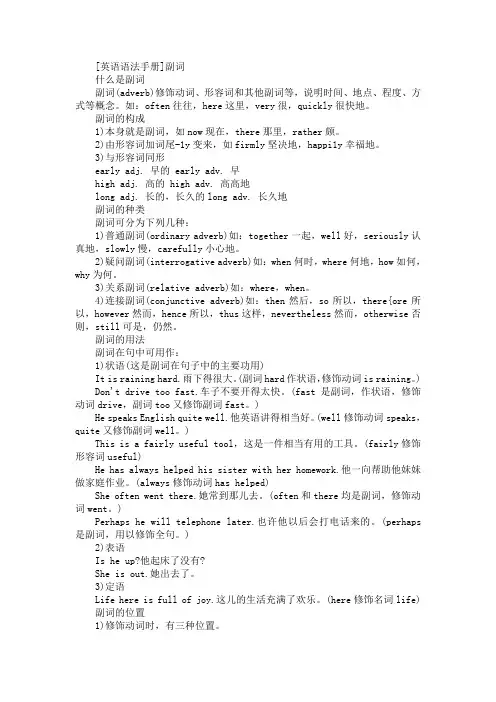
[英语语法手册]副词什么是副词副词(adverb)修饰动词、形容词和其他副词等,说明时间、地点、程度、方式等概念。
如:often往往,here这里,very很,quickly很快地。
副词的构成1)本身就是副词,如now现在,there那里,rather颇。
2)由形容词加词尾-1y变来,如firmly坚决地,happi1y幸福地。
3)与形容词同形early adj. 早的 early adv. 早high adj. 高的 high adv. 高高地long adj. 长的,长久的long adv. 长久地副词的种类副词可分为下列几种:1)普通副词(ordinary adverb)如:together一起,well好,seriously认真地,slowly慢,carefully小心地。
2)疑问副词(interrogative adverb)如:when何时,where何地,how如何,why为何。
3)关系副词(relative adverb)如:where,when。
4)连接副词(conjunctive adverb)如:then然后,so所以,there{ore所以,however然而,hence所以,thus这样,nevertheless然而,otherwise否则,still可是,仍然。
副词的用法副词在句中可用作:1)状语(这是副词在句子中的主要功用)It is raining hard.雨下得很大。
(副词hard作状语,修饰动词is raining。
) Don't drive too fast.车子不要开得太快。
(fast是副词,作状语,修饰动词drive,副词too又修饰副词fast。
)He speaks English quite well.他英语讲得相当好。
(well修饰动词speaks,quite又修饰副词well。
)This is a fairly useful tool,这是一件相当有用的工具。
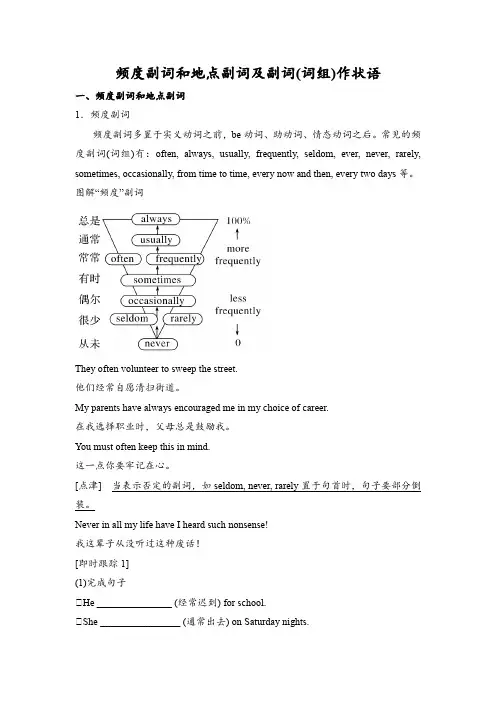
频度副词和地点副词及副词(词组)作状语一、频度副词和地点副词1.频度副词频度副词多置于实义动词之前,be动词、助动词、情态动词之后。
常见的频度副词(词组)有:often, always, usually, frequently, seldom, ever, never, rarely, sometimes, occasionally, from time to time, every now and then, every two days等。
图解“频度”副词They often volunteer to sweep the street.他们经常自愿清扫街道。
My parents have always encouraged me in my choice of career.在我选择职业时,父母总是鼓励我。
You must often keep this in mind.这一点你要牢记在心。
[点津]当表示否定的副词,如seldom, never, rarely置于句首时,句子要部分倒装。
Never in all my life have I heard such nonsense!我这辈子从没听过这种废话完成句子①He _______________ (经常迟到) for school.②She ________________ (通常出去) on Saturday nights.③My uncle _________________ (将永远不会忘记) what happened to him yesterday.(2)句型转换①I have never seen such a moving film.→Never _____________ such a moving film.②He seldom goes to see a film.→Seldom ___________ to see a film.2.地点副词地点副词通常放在句尾,也可放在句首、句中。
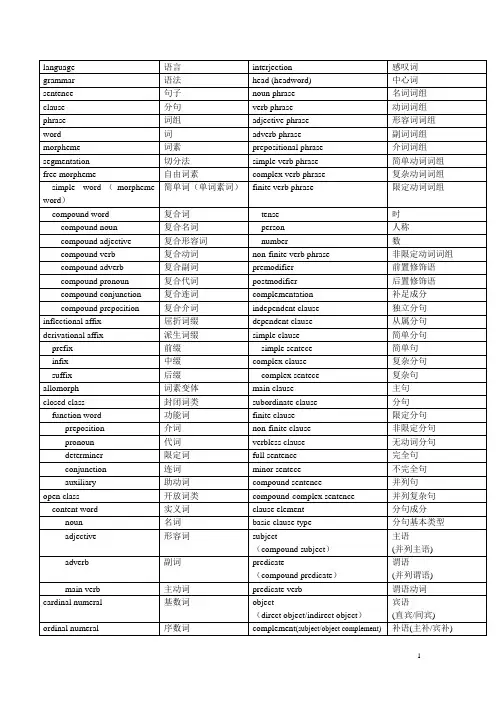
language 语言interjection 感叹词grammar 语法head (headword) 中心词sentence 句子noun phrase 名词词组clause 分句verb phrase 动词词组phrase 词组adjective phrase 形容词词组word 词adverb phrase 副词词组morpheme 词素prepositional phrase 介词词组segmentation 切分法simple verb phrase 简单动词词组free morpheme 自由词素complex verb phrase 复杂动词词组simple word(morphemeword)简单词(单词素词)finite verb phrase 限定动词词组compound word 复合词tense 时compound noun 复合名词person 人称compound adjective 复合形容词number 数compound verb 复合动词non-finite verb phrase 非限定动词词组compound adverb 复合副词premodifier 前置修饰语compound pronoun 复合代词postmodifier 后置修饰语compound conjunction 复合连词complementation 补足成分compound preposition 复合介词independent clause 独立分句inflectional affix 屈折词缀dependent clause 从属分句derivational affix 派生词缀simple clause 简单分句prefix 前缀simple sentece 简单句infix 中缀complex clause 复杂分句suffix 后缀complex sentece 复杂句allomorph 词素变体main clause 主句closed class 封闭词类subordinate clause 分句function word 功能词finite clause 限定分句preposition 介词non-finite clause 非限定分句pronoun 代词verbless clause 无动词分句determiner 限定词full sentence 完全句conjunction 连词minor sentece 不完全句auxiliary 助动词compound sentence 并列句open class 开放词类compound-complex sentence 并列复杂句content word 实义词clause element 分句成分noun 名词basic clause type 分句基本类型adjective 形容词subject(compound subject)主语(并列主语)adverb 副词predicate(compound predicate)谓语(并列谓语)main verb 主动词predicate verb 谓语动词cardinal numeral 基数词object(direct object/indirect object)宾语(直宾/间宾)ordinal numeral 序数词complement(subject/object complement)补语(主补/宾补)adverbial 状语indefinite article 不定冠词SVC, SV, SVO, SV oO, SVOC,SV A, SVOA zero article 零冠词concord/agreement 一致possessive determiner 物主限定词subject-verb agreement 主动一致/主谓一致genitive noun 名词属格grammatical concord 语法一致原则demonstrative determiner 指示限定词notional concord 意义一致原则relative determiner 关系限定词principle of proximity 就近原则interrogative determiner 疑问限定词coordinate subject 并列结构作主语indefinite determiner 不定限定词noun phrase of amount or quality 表示数量概念的名词词组multiplicative numeral 倍数词relative clause 关系分句fractional numeral 分数词relative pronoun 关系代词quantifier 量词antecedent 先行项specific reference 特指cleft sentence 分裂句generic reference 类指focus element 中心成分definite specific reference 确定特指existential sentence 存在句anaphoric specific reference 前照应特指notional subject 实义主语cataphoric specific reference 后照应特指coordinate construction 并列结构situational reference 语境照应(特指)coordinate element 并列成分definite quantity 确定数量simple noun 简单名词indefinite quantity 非确定数量compound noun 复合名词referential meaning 所指意义derivative noun 派生名词predeterminer 前位限定词common noun 普通名词central determiner 中位限定词individual noun 个体名词postdeterminer 后位限定词collective noun 集体名词person pronoun 人称代词material noun 物质名词subjective case 主格abstract noun 抽象名词objective case 宾格proper noun 专有名词genitive case 属格countable/count noun 可数名词possessive pronoun (genitive pronoun)物主代词(属格代词) uncountable/non-count noun 不可数名词nominal genitive pronoun 名词性属格代词number 数possessive genitive pronoun 限定词属格代词singular number 单数reflexive pronoun 反身代词plural number 复数reciprocal pronoun 相互代词regular plural 规则复数demonstrative pronoun 指示代词irregular plural 不规则复数indefinite pronoun 不定代词partitive/unit noun 单位词/单位名词interrogative pronoun 疑问代词case 格relative pronoun 关系代词common case 通格gender 性possessive case/genitive case 所有格/(名词)属格masculine gender 阳性independent genitive 独立属格feminine gender 阴性double genitive 双重属格neuter gender 中性determiner 限定词common gender 通性definite airicle 定冠词noun of common gender 通性名词person 人称complementation 补足成分first person 第一人称transitive verb 及物动词second person 第二人称intransitive verb 不及物动词third person 第三人称linking verb 连系动词Reflexive form 反身形式dynamic verb 动态动词emphatic use 强调用法stative verb 静态动词unemphatic use 非强调用法single-word verb 单词动词reference 照应,所指phrasal verb 词组动词pronoun reference 代词照应finite verb (finite form)限定动词(限定形式)anaphoric reference 前照应non-finite verb(non-finite form)非限定动词(非限定形式)cataphoric reference 后照应base form 原形situational reference 语境照应grammatical form 语法形式person reference 人称照应simple tense 一般现在时demonstrative reference 指示照应simple past 一般过去时tense 时present progressive 现在进行时present tense 现在时past progressive 过去进行时past tense 过去时present perfective 现在完成时aspect 体past perfective 过去完成时progressive aspect 进行体present perfective progressive 现在完成进行时perfective aspect 完成体past perfective progressive 过去完成进行时voice 态future tense 将来时active voice 主动态operator 操作词passive voice(be-passive/get-passive/passi ve infinitive)被动态(be型/get型被动态/不定式被动态)predication 述谓成分mood 式Old English 古英语indicative mood 陈述式prediction 预见statement(declarative sentence)陈述句willingness 意愿question(interrogative sentence)疑问句intention 意图imperative mood 祈使式infinitive(to-infinitive/bare-infinitive)不定式(带to/不带to不定式) subjunctive mood 虚拟式-ing participle ing分词hypothetical meaning 假设意义-ed participle ed分词non-factual meanig 非事实意义conditional 条件句Be-subjunctive Be型虚拟式implied conditional 含蓄条件句Were-subjunctive Were型虚拟式ability 能力auxiliary 助动词possibility 可能primary auxiliary 基本助动词permission 许可modal auxiliary 情态助动词obligation 义务(必须,应该)semi-auxiliary 半助动词necessity 必然simple verb phrase 简单动词词组determination 决心complex verb phrase 复杂动词词组epistemic 推测性notional verb 实义动词non-epistemic 非推测性deep structure 深层结构emphasizer 强调词surface structure 表层结构reinforcement tag 强调附加结构dynamic adjective 动态形容词double negative 双重否定stative adjective 静态形容词rhetorical question 修辞疑问句present participle 现在分词partial negation 局部否定past participle 过去分词question(interrogative sentence)疑问句gerund 动名词general question(yes-no question)一般疑问句(是非疑问句)dangling participle (unattached participle) 悬垂分词(无依着分词)special question (wh-question)特殊疑问句(wh-问句)attachment rule 依着规则alternative question 选择疑问句logical suject 逻辑主语tag question 附加疑问句one-word adjective 单词形容词non-assertive word 非肯定词compound adjective 复合形容词command (imperative sentence) 祈使句central adjective 中心形容词existential sentence 存在句peripheral adjective 外围形容词notional subject 实义主语gradable ajective 等级形容词real subject 真主语non-gradable ajective 非等级形容词locative adverbial 地点状语causative construction 使役结构temporal adverbial 时间状语simple adverb 简单副词nonreferring it 非指代性it derivative adverb 派生副词empty it 虚义it adverb of manner 方式副词anticipatory it 先行it adverb of degree 程度副词pseudo-clef sentence 拟似分裂句adverb of time 时间副词coordinator 并列(连)词adverb of frequency 频率副词correlative coordinator 关联并列连词adverb of place 地点副词coordinate construction 并列结构conjunctive adverb 连接副词subordination 从属explanatory adverb 解说副词subordinator 从属连词adjunct 修饰/结合性状语simple subordinator 简单从属连词dsjunct 评注/分离性状语complex subordinator 复杂从属连词conjunct 连接性状语correlative subordinator 关联从属连词positive/absolute degree 原级marginal subordinator 边际从属连词comparative degree 比较级one-word subordinator 单词从属连词superlative degree 最高级adverbial clause of time 时间状语分句synthetic form 综合形式adverbial clause of place 地点状语分句analytic form 分析形式adverbial clause of manner 方式状语分句comparative constructure 比较结构adverbial clause of cause 原因状语分句analytic language 分析性语言adverbial clause of result 结果状语分句simple preposition 简单介词adverbial clause of purpose 目的状语分句complex preposition 复杂介词adverbial clause of condition 条件状语分句two-word preposition 双词介词adverbial clause of concession 让步状语分句three-word preposition 三词介词Infinitive clause 不定式分句four-word preposition 四词介词-ing participle clause -ing分词分句exclamation(exclamatory sentence)感叹句-ed participle clause -ed分词分句quasi-coordinator 近似并列连词end weight 句尾重心absolute construction 独立结构information focus 信息焦点relative word 关系词information unit 信息单位relative pronoun 关系代词old information (given information) 旧信息(已知信息)relative adverb 关系副词new information 新信息relative determiner 关系限定词full inversion 全部倒装attributive clause (relative clause) 定语从句(关系分句)partial inversion 部分倒装restrictive relative clause 限定性关系分句cohesion 粘着性non-restrictive relative clause 非限定性关系分句coherence 连贯性double relative clause 双重关系分句unity 统一性embedded relative clause 嵌入式关系分句redundancy 累赘conditional 条件句correctness 正确性real conditional 真实条件句communicative pfunction 交际功能unreal conditional 非真实条件句transitional words/phrases 过渡词语basic form 基本形式logical connectors 逻辑纽带variant form 变体形式grammatical connectors 语法纽带alternative form 替换形式coreference pro-form 指代词direct speech 直接引语comparative reference 对比照应indirect speech 间接引语parallel construction 平行结构reporting verb 引述动词key word 关键词modification 修饰语synonym (near-synonym) 同义词(近义词)restrictive modifier 限制性修饰语sentence group 句群(语段)non-restrictive modifier 非限制性修饰语text 语篇discontinuous modification 分隔修饰single-sentence group text 单语段语篇appositive 同位语multi-sentence group text 多语段语篇restrictive appositive 限制性同位语top sentence 主题句non-restrictive appositive 非限制同位语topic sentence group 主题语段substitute 替代词supporting sentence 辅助句nominal substitute 名词性替代词supporting sentence group 辅助语段verbal substitute 动词性替代词clausal substitute 分句性替代词substitution 替代nominal substitution 名词性替代verbal substitution 动词性替代clausal substitution 分句性替代ellipsis 省略word order 词序normal order 正常词序natural order 自然词序postponement 后置fronting 前置end focus 句尾焦点。
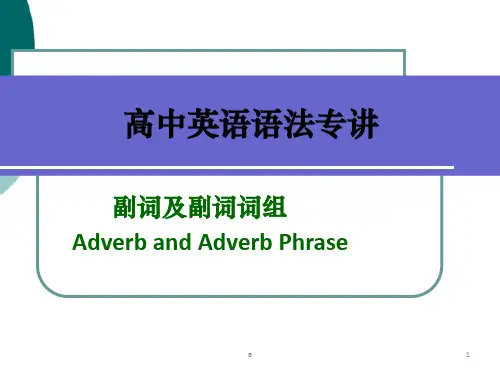
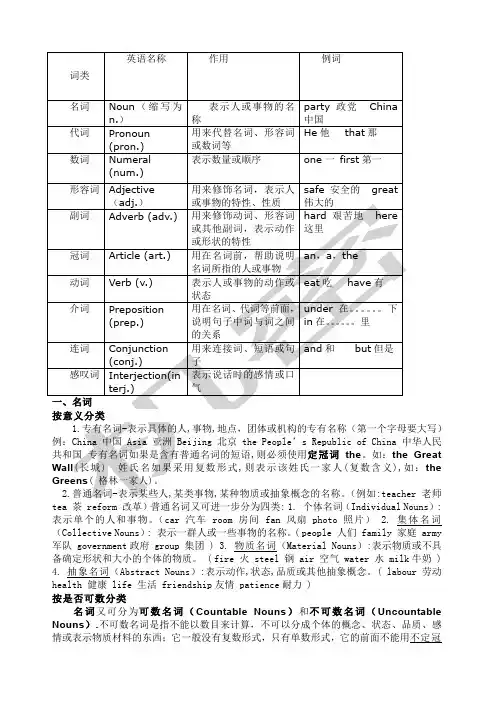
词类英语名称作用例词名词Noun(缩写为n.)表示人或事物的名称party政党China中国代词Pronoun(pron.) 用来代替名词、形容词或数词等He他that那数词Numeral(num.)表示数量或顺序one一first第一形容词Adjective(adj.)用来修饰名词,表示人或事物的特性、性质safe安全的great伟大的副词Adverb (adv.) 用来修饰动词、形容词或其他副词,表示动作或形状的特性hard艰苦地here 这里冠词Article (art.) 用在名词前,帮助说明名词所指的人或事物an,a,the动词Verb (v.) 表示人或事物的动作或状态eat吃have有介词Preposition(prep.) 用在名词、代词等前面,说明句子中词与词之间的关系under在。
下in在。
里连词Conjunction(conj.) 用来连接词、短语或句子and和but但是感叹词Interjection(interj.) 表示说话时的感情或口气一、名词按意义分类1.专有名词-表示具体的人,事物,地点,团体或机构的专有名称(第一个字母要大写)例:China 中国 Asia 亚洲 Beijing 北京the People’s Republic of China 中华人民共和国专有名词如果是含有普通名词的短语,则必须使用定冠词the。
如:the Great Wall(长城) 姓氏名如果采用复数形式,则表示该姓氏一家人(复数含义),如:the Greens( 格林一家人)。
2.普通名词-表示某些人,某类事物,某种物质或抽象概念的名称。
(例如:teacher 老师tea 茶 reform 改革)普通名词又可进一步分为四类: 1. 个体名词(Individual Nouns):表示单个的人和事物。
(car 汽车 room 房间 fan 风扇photo 照片) 2. 集体名词(Collective Nouns): 表示一群人或一些事物的名称。
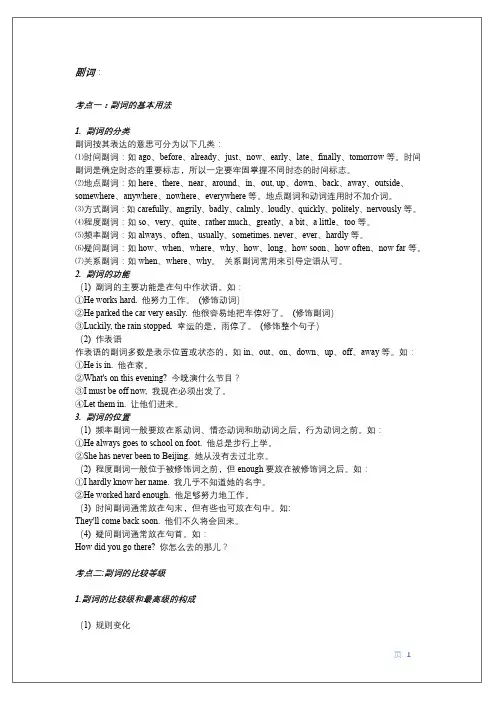
副词:考点一:副词的基本用法1. 副词的分类副词按其表达的意思可分为以下几类:⑴时间副词:如ago、before、already、just、now、early、late、finally、tomorrow等。
时间副词是确定时态的重要标志,所以一定要牢固掌握不同时态的时间标志。
⑵地点副词:如here、there、near、around、in、out, up、down、back、away、outside、somewhere、anywhere、nowhere、everywhere等。
地点副词和动词连用时不加介词。
⑶方式副词:如carefully、angrily、badly、calmly、loudly、quickly、politely、nervously等。
⑷程度副词:如so、very、quite、rather much、greatly、a bit、a little、too等。
⑸频率副词:如always、often、usually、sometimes. never、ever、hardly等。
⑹疑问副词:如how、when、where、why、how、long、how soon、how often、now far等。
⑺关系副词:如when、where、why。
关系副词常用来引导定语从可。
2. 副词的功能(1) 副词的主要功能是在句中作状语。
如:①He works hard. 他努力工作。
(修饰动词)②He parked the car very easily. 他很容易地把车停好了。
(修饰副词)③Luckily, the rain stopped. 幸运的是,雨停了。
(修饰整个句子)(2) 作表语作表语的副词多数是表示位置或状态的,如in、out、on、down、up、off、away等。
如:①He is in. 他在家。
②What's on this evening? 今晚演什么节目?③I must be off now, 我现在必须出发了。
词组大全英语英语词组大全一、名词词组1. 名词词组的基本结构名词词组是由一个或多个名词通过添加适当的修饰语组成。
例如:apple(苹果),red apple(红苹果),a red apple(一个红苹果)。
2. 名词所有格名词所有格表示某物的归属,通过在名词后面加's或'构成。
例如:John's book(约翰的书)。
二、动词词组1. 动词词组的基本结构动词词组是由一个或多个动词通过添加适当的助动词、情态动词或时态动词组成。
例如:go to school(去上学),want to go(想要去)。
2. 动词短语动词短语是指由一个或多个动词与其他词语一起组成的固定搭配。
例如:look for(寻找),come from(来自)。
三、形容词词组1. 形容词词组的基本结构形容词词组是由一个或多个形容词通过添加适当的修饰语组成。
例如:beautiful flowers(美丽的花朵),the most beautiful flower(最美丽的花朵)。
2. 形容词的比较级和最高级形容词的比较级和最高级是通过添加适当的比较级或最高级词尾-er、-est 构成的。
例如:happier(更快乐),happiest(最快乐)。
四、副词词组1. 副词词组的基本结构副词词组是由一个或多个副词通过添加适当的修饰语组成。
例如:quickly (快速地),the most quickly(最快地)。
2. 副词的比较级和最高级副词的比较级和最高级是通过添加适当的比较级或最高级词尾-lier、-liest构成的。
例如:closest(最近),closest of all(最最近)。
五、介词词组1. 介词词组的基本结构介词词组是由一个或多个介词通过添加适当的修饰语组成。
例如:in the morning(在早上),during the day(在白天)。
2. 介词的固定搭配介词与其他词语之间存在许多固定搭配,这些搭配通常是固定的,不能随意更改。
初中英语语法归纳:副词初中英语学习最难的是语法,因为英语的语法跟汉语的语法有很大的不同。
初中也要副词用法有很多种。
下面为大家讲解一下初中英语副词的用法。
副词在句中主要用作状语,修饰动词、形容词、副词、介词短语或句子。
初中英语副词的用法:⑴修饰动词,表示时间、地点、程度、方式、频度等。
一般位于动词之后,如果动词有宾语,则要位于宾语之后。
频度副词常位于助动词和连系动词be 之后或实义动词之前。
例如:He arrived only yesterday. 他是昨天才到的。
There were clothes lying here and there on the floor. 地板上到处都是衣服。
I have been terribly worried about you all day. 我一整天都非常为你担心。
She plays the piano very well. 她钢琴弹得很好。
The boy is always asking his parents for money. 那个男孩老是向他父母要钱。
She never goes to the cinema. 她向来不看电影。
⑵修饰形容词、副词、介词短语,一般前置,只有enough例外,需要后置。
例如:She seems quite happy. 她看上去相当愉快。
You've done rather badly in the test. 你考得够糟糕的。
The wind was right in our faces. 风迎面吹来。
This girl is not old enough to go to school. 这个女孩还没有到上学的年龄。
He didn't run fast enough to catch the train. 他跑得不够快,没有赶上火车。
⑶用作表语,多为与介词同形的副词和表示方位的副词。
例如:Is anybody in? 里面有人吗?有人在家吗?Father is away. 父亲离家在外。
副词重要的英语语法人脑是一个先进的计算机,可是却不曾有过配套的说明书或者使用指南。
先学会了学习这件事情,再来学习。
下面是给大家整理的一些属格的学习英语语法学习资料,希望对大家有所帮助。
关于副词一、副词的概念副词(adverb,简写为adv)是一种用来修饰形容词、形容词、全句的词,说明时间、地点、程度、方式等概念的词。
副词是一种半虚半实的该词。
副词可分为:地点副词、方式副词、程度副词、疑问副词、连接副词。
二、副词的分类1.根据意义分类 (1)方式副词,一般用来回答“怎样地?”这类问题,具有最典型的状语为形式,绝大部分都加和是由一个形容词加形容词-ly构成。
如:calmly冷静地,carefully仔细地,小心地,carelessly粗心地,patiently耐心地,politely礼貌地,proudly自豪地,properly适当地,quickly快速地,rapidly迅速地,suddenly突然,successfully成功地,wi1lingly情愿地,warmly热情地。
句子中的位置:①.修饰不及物动词的方式副词要放在被修饰词之后 1)His sister sings well. 2)The baby issleeping soundly. ②.修饰及物动词的方式副词可放在被修饰词之前或及物动词之后;如果宾语较长, 也可放在动词和宾语之间(1)He speaks French fluently. 2)All this morning Liu Ying has been writingcarefully some English letters to her teachers.(2)地点副词,包括表示地点的副词和表示横杆以及关系、方向的副词,如:here这里,there那里,upstairs楼上,downstairs楼下,anywhere任何地方,above在上方,up上面,down下面,east向东,west向西,等。
中考英语语法精讲:副词副词是一般只能位于谓词性成分之前,充当修饰限制成分而不受其他成分修饰限制的词类。
论文在意义的基础上,以副词的语法功能为标准,将《国语》副词划分为否定副词、范围副词、程度副词、时间副词、语气副词、情状方式副词和关联副词七个大类。
同时,每个副词大类内部又根据句法语义特点进行次分类。
一、副词的定义表示行为特征或性状特征的词叫副词(Adverb)。
副词常用来修饰动词、形容词、其它副词或全句,用来说明时间、地点、程度、方式等概念。
例如:The girl works hard.(hard修饰动词work)It is very cold today.(very修饰形容词cold)Mostly Ihave lunch at school.(mostly修饰全句)Look! It's snowing very heavily.(very修饰副词heavily)二、副词的种类常见的副词分类如下:时间副词today,now,soon,recently,ago,before,since,finally地点副词here,there,up,down,about,inside,outside程度副词very,much,enough,almost,little,still,quite,so,nearly频度副词usually,sometimes,never,ever,always,often,once,seldom方式副词well,fast,slowly,carefully,badLy,hard,quickly,happily疑问副词how,when,where,why否定副词no,not,hardly,neither,nor关系副词when,where,why连接副词yet,so,however,then,how,when,where,whether,why三、副词的用法1.在句子中作状语Tom,quickly picked up his bag and then went to school.汤姆赶快捡起书包,然后上学去了。
副词副词用来修饰动词、形容词、其他副词或整个句子,有时也可修饰名词,表示时间、地点、方式、程度、动作特征等。
1 副词的分类1-1 六分法根据词汇意义,我们把副词分为6种,见下:名称例词now 现在,then 那时,already已经,ago 以前,tonight 今晚,never时间副永不,ever曾经,usually通常,词soon 很快,today今天,often经常,late 迟到,tomorrow 明天,immediately立刻here这里,there 那里,nowhere任何地方都不,above 在高处,below在下面,back在后面,outside在外地点副面,in 在里面,out 在外面,down词在下面,up在上面,inside在里面,indoors在室内,outdoors在户外,everywhere到处,upstairs在楼上,downstairs 在楼下,far在远处方式副slowly缓慢地,fast 快地,well很词好,badly拙劣地,carefully 细心地,alone 独自地,together一起,kindly和蔼地,simply简直,suddenly突然地,hard努力地often 经常,always总是,once从前,from time to time不时地,频度副several times数次,daily每天,词every year 每年,again and again 一次又一次,sometimes 有时,constantly经常地,frequently频繁地,forever总是very 很,too 太,quite 很,almost几乎,much非常,still仍然,程度副enough充足地,fairly 相当,hardly词几乎不,rather相当,little很少地,extremely极其,abit有一点,entirely 完全地,nearly 几乎,half一半briefly简洁地,generally一般来说,评述副naturally自然地,roughly大体上,词honestly诚实地,luckily 幸运地,broadly广义上,happily幸运地1-2 三分法根据句法功能,副词有3种,见下表:名称例词用法特疑问副when什么时候,how怎位于句7样,where在哪里,why 首,后词为什么,however 究竟如接一般何,whenever 究竟什么时疑问句候,wherever 究竟哪里when (=the time when),where (=the place 引导主where), how (=the way 语从连接副in which, the way that), 句、宾词why (=the reason why), 语从句whenever (=any time 或表语when), wherever (=any 从句place where), however(=any way that)关系副when……的时候,where 引导定词……的地方,why……的原因语从句提示形容词+-ly变副词的方法。
英语语法副词副词及其基本用法副词主要用来修饰动词,形容词,副词或其他结构。
一、副词的位置1)在动词之前。
2)在be动词、助动词之后。
3)多个助动词时,副词一般放在第一个助动词后。
注意:a. 大多数方式副词位于句尾,但宾语过长,副词可以提前,以使句子平衡。
例如:We could see very clearly a strange light ahead of us.我们清楚地看到前面有奇怪的光。
b. 方式副词well,badly,hard等只放在句尾。
例如:He speaks English well. 他英语说得好。
二、副词的排列顺序:1)时间,地点副词2)方式副词:短的在前,长的在后,并用and或but等连词连接。
例如:Please write slowly and carefully. 请写得慢一些,仔细一些3)多个不同副词排列:程度+地点+方式+时间副词。
注意:副词very 可以修饰形容词,但不能修饰动词。
I like English very much.注意:副词enough要放在形容词的后面,名词前。
例如:The book is good enough to read.There is enough food for everyone to eat.三.兼有两种形式的副词1)close与closelyclose意思是"近";closely 意思是"仔细地"。
例如:He is sitting close to me. 他就坐在我边上。
Watch him closely. 盯着他。
2)late 与latelylate意思是"晚";lately 意思是"最近"。
例如:You have come too late. 你来得太晚了。
What have you been doing lately? 近来好吗?3)deep与deeplydeep意思是"深",表示空间深度;deeply时常表示感情上的深度,"深深地"。
英语语法—副词的种类一、按意义来分,副词可分为情状副词、程度副词、地方副词、时间副词、频率副词和肯定否定副词。
按用法来分,副词可分为简单副词、疑问副词和关系副词。
1.情状副词表示状态、性质或方式。
(1)情状副词用在不及物动词后。
The snack of that place tastes wonderfully good.那地方的小吃惊人的好吃。
He runs fast.他跑得快。
(2)情状副词用在不及物动词与介系词之间或句尾。
(误)He spoke to slowly the foreigner.(正)He spoke slowly to the foreigner.(正)He spoke to the foreigner slowly.中文:他慢慢地与那个外国人说话。
(3)情状副词用在及物动词前或句尾。
(误)He left quietly the room.(正)He quietly left the room.(正)He left the room quietly.中文:他静静地离开了房间。
(4)情状副词用在所修饰的形容词或副词前。
It is really important.这真的重要。
The tree grows wonderfully fast.这树长得快得惊人。
(5)情状副词用在BE与分词之间或句尾。
(误)He is reading loudly the newspaper.(正)He is loudly reading the newspaper.(正)He is reading the newspaper loudly.中文:他正在大声读报。
(6)情状副词在句首,加强语气。
Quickly I picked up the gun.我迅速拿起枪。
2.程度副词表示动词、形容词或其他副词的程度,如:too(太), very(非常), much(很), almost(几乎), nearly(几乎),enough(充分), hardly(几乎不)等。
I will miss you very much.我将会非常想念你的。
(1)程度副词用在一般动词前。
I almost forgot to bring my keys.我差点忘记带钥匙。
(2)程度副词用在助动词与主要动词之间。
I could hardly believe it.我几乎不能相信它。
(3)程度副词用在形容词或副词前,enough除外。
He drives very carefully.他驾驶很小心。
He is old enough to go to school.他够年龄,可以上学了。
enough位于所修饰的形容词之后。
(4)程度副词much(...得多), even(更加)可在形容词或副词的比较级之前作修饰语。
This question is much more difficult than that one.这个问题比那个问题难多了。
Canada is even larger than the United States.加拿大甚至比美国还大。
3.地方副词表示地方或方向,如:here(这里), there(那里), outdoors(在户外), out(在外), home(在家), abroad(在国外)等。
(1)地方副词用在主要动词后。
After work he went home.工作结束后他回家。
(2)若两个地方副词同时出现,则小地方在前,大地方在后。
Ribb was born at Sydney in Australia.瑞柏出生于澳洲的雪梨。
(3)here, there作地方副词可放在句首,用以加强语气。
Here I am.我在这里。
(4)地方副词up(向上), down(向下), on(上), off(离去)等与及物动词连用,形成片语动词;名词可在及物动词与副词之间或之后,代名词只能在及物动词与副词之间。
【参见地方介系词】I turned on the radio.I turned the radio on.我打开收音机。
I turned it on.我打开它。
不能说I turned on it.4.时间副词表示时间或期间,如:today(今天), tomorrow(明天), yesterday(昨天), now(现在), soon(不久), then(那时), recently(近来), lately(近来), afterwards(后来)等。
(1)时间副词用在句尾。
I went to the bar yesterday.我昨天去酒吧了。
I shall go to Beijing for a meeting tomorrow.亲爱的,明天我将去北京开个会。
(2)时间副词用在句首以加强语气。
Tomorrow I shall attend a meeting.明天我将参加会议。
(3)句中若出现多个时间副词,短时间在前,长时间在后。
It took place at 4 o'clock on the 4th of May, 1896.它发生于一八九六年五月四日四点钟。
(4)表示时间的副词或副词片语前不加介系词或定冠词。
(误)He will be back on next Monday.(误)He will be back the next Monday.(正)He will be back next Monday.他下星期一回来。
(5)still(还,仍然), yet(还,仍然)等是特殊的时间副词,一般用于强调某种句型, still表示动作或状态的持续作"仍然"讲, yet用于疑问句作"已经"讲,用于否定句作"还"讲。
I am still standing.我还在站着。
Is everything ready yet?一切都准备好了吗?5.频率副词是表示与次数,频率有关的副词,如:always(总是), usually(经常), sometimes(有时), seldom(不常), once(一次), twice(两次)等。
I decide to call you twice a day.我决定一天给你打两次电话。
(1)频率副词用在BE后。
It is usually hot in summer.夏天天气通常是热的。
(2)频率副词用在主要动词前。
My father usually walks home.我的父亲经常步行回家。
(3)频率副词用在助动词与主要动词之间。
I will always love you.我将永远爱你。
(4)频率副词用在OUGHT TO之间。
You ought often to write to your mother.你应该常给你母亲写信。
(5)在答句中,频率副词必须放在助动词前。
Do you often go there?你常去那里吗?(误)Yes, I do often.是的,我常去。
(正)Yes, I often do.是的,我常去。
(6)never(从不), seldom(很少,不常)用于句首时,句子要用倒装形式以加强语气。
Never have I been there.我从未去过那里。
Seldom do I watch TV.我很少看电视。
6.肯定否定副词表示肯定或否定意义,如:yes(是的), no(不), not(不), never(绝不), surely(当然地), certainly(一定地)等,主要修饰全句或动词。
(1)肯定副词与否定副词不能同时出现。
I will not be back until next Friday.我将在下周五回来。
Is he not a student?他不是学生吗?(误)Yes, he is not a student.是的,他不是学生。
(正)No, he is not a student.是的,他不是学生。
(2)否定副词必须接在第一个助动词后。
(误)You should have not asked this question yesterday. (正)You should not have asked this question yesterday.你昨天不该问这个问题。
(3)否定副词如never, scarcely在句首,句子要用倒装形式,表示加强语气。
Scarcely does he wear glasses though he is near-sighted.虽然他近视,但他很少戴眼镜。
7.疑问副词是问何时、何地、如何、因何的副词,主要有when, where, how, why。
(1)疑问副词用在句首。
How long will you stay there?你将在那里待多久?How long have you been staying in America?你在美国待多久了?(2)疑问副词在句中引导名词子句。
I want to know where she has gone.我想知道她去哪里了。
(3)疑问副词后接不定词构成的名词片语,在句中可以作主词、受词或主词补语。
How to solve the problem gives him a bad headache.如何解决这个问题使他伤透脑筋。
How to solve the problem作主词。
I don't know how to answer the question.我不知道如何回答这个问题。
how to answer the question作受词。
The patient is in urgent need the medicine, but the problem is where to get it.这个病人急需这种药,但问题是哪里能找到。
where to get it作主词补语。
(4)疑问副词引导的名词子句可作主词、受词或主词补语。
When we are to start the competition hasn't fixed yet.我们什么时候开始比赛还没有定下来。
When we are to start the competition作主词。
She asked her husband where he had been.她问她丈夫去哪里了。
where he had been 作受词。
The question is when we can finish our work.问题是我们何时能完成我们的工作。
when we can finish our work作主词补语。
8.关系副词兼有副词与连接词两种作用。
(1)关系副词所引导的形容词子句用于修饰主要子句中的某一名词或代名词,被修饰的词称作先行词,关系副词要放在先行词之后。